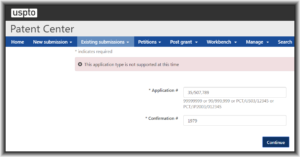
(This is Patentcenter trouble ticket number CP22.)
(This has still not been fixed as of June 10. I phoned the EBC to open another trouble ticket. The new ticket number is 1-696205867.)
I was quite surprised today to be reminded that a defect in Patentcenter that I had reported to the USPTO back in December of 2019 has still not been corrected. The defect is that it is impossible, in Patentcenter, to e-file any follow-on submission in any 35-series design patent application. You can see this in the screen shot at right.
There are about a dozen kinds of patent applications in the USPTO, each represented by its own “series code”. One “series code” is 35. The series code 35 is what USPTO assigned to design patent applications that entered the USPTO by way of a designation of the US in a Hague Agreement application (an international design application).
By way of background, the US joined Hague Agreement in May of 2015. From that time, it became possible for any applicant who filed an international design application (a so-called “Hague application”) to designate the US. If the applicant were to do so, then the International Bureau would transmit a copy of the international design application to the USPTO and the USPTO would assign a 35-series application number to the application.
The reader will appreciate that the applicant might then find the need to e-file some document in that 35-series US design patent application. Maybe the applicant would need to respond to an Office Action, for example.
As I say, there are only about 12 kinds of patent applications in the USPTO. Now you might think that the developers who wrote the code for Patentcenter would have tested the code that they had just written by (among other things) doing at least one test filing of a document with each of the 12 or so series codes. But you would be wrong. As you can see from the screen shot above, Patentcenter is broken. It rejects any follow-on filing for which the series code is 35. I have tested this with many different 35-series patent applications and the result is the same. The error message very consistently is:
This application type is not supported at this time.
As I say, I reported this to USPTO back in December of 2019. It needs to get fixed.
